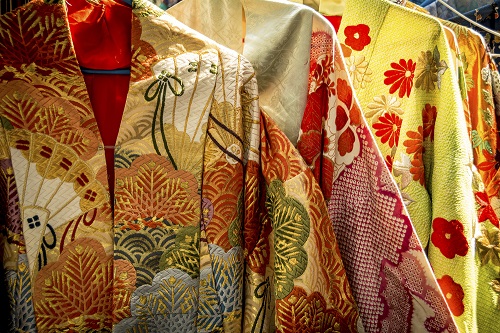
When you think Japan and Japanese aesthetic, the kimono immediately comes to mind. This deceptively simple but eternally elegant garment has been the national dress of the Japanese for centuries.
The T-shaped straight kimono we know today, which is intricately wrapped, folded, and belted to fit the wearer, developed as a riff on ancient Japanese robes in the first millennium A.D. The straight kimono was an innovation much appreciated at the time since it was far easier to fold and store, it lent itself to layering, and thus was suitable for all seasons, and because of the T-shape, tailors did not have to custom measure, but rather mass-produced a handful of lengths suitable for most bodies.
In the seventeenth and eighteenth centuries, kimonos became ever more colorful and elaborate as the socially ambitious chōnin or merchant class used fabric, embroidery, and color to announce their growing wealth. When this one-upmanship threatened to get out of control, the ruling shogunate imposed a restraining set of rules governing which colors and patterns were permissible, and this gave way to the more subdued aesthetic we associate with kimonos today.
As nineteenth century Japan struggled to assert her dominance against the western powers, civil servants were required to wear western clothes in the workplace. This continued during Japan’s post-war reconstruction era, with more strict rules about where and how a kimono could be worn; the kimono became a conservative dress style of the elderly, traditional, and limited to formal occasions such as weddings, funerals, and tea ceremonies. Today, however, young Japanese are rediscovering the kimono and incorporating it into everyday dress for a hybrid fashion that is all the rage in Tokyo.
Tokyo offers numerous venues to experience and purchase kimonos.
The Daimaru Department Store’s high end 10th floor kimono boutique is steps away from bustling Tokyo Station and is where the well-heeled women of Tokyo order exquisite bespoke kimonos for the most formal of occasions.
The Ome Kimono Museum displays kimonos of the past and part of the extensive collection of the Imperial Household.
Gallery Kawano Omotosando near the famous Shibuya Crossing is a must for textile lovers and vintage clothing buffs, offering affordable secondhand and vintage kimonos for both men and women in a dazzling array of fabrics and colors. This is the best place to find an authentic but affordable Japanese kimono, starting at around $90.
Alexander+Roberts offers numerous options for travel to Japan, from
Tokyo Private Tours to our escorted small group itinerary,
From Japan’s Inland Sea to the Alps.